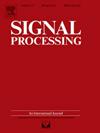具有自适应加权平均滤波和各向异性扩散滤波的主动轮廓模型
IF 3.4
2区 工程技术
Q2 ENGINEERING, ELECTRICAL & ELECTRONIC
引用次数: 0
摘要
活动轮廓模型是一种经典而有效的图像分割方法。然而,对于光照不均匀和噪声引起的强度不均匀图像的分割,现有的大多数ACMs都无法获得满意的分割精度。为了解决这个问题,本工作提出了一种自适应加权平均滤波和各向异性扩散滤波(AWMAD)的ACM。首先,我们提出了一种对数减法机制来分解原始图像的不均匀光照和噪声,将具有边缘特征的高频成分从原始图像中分离出来;然后,我们提出了一种基于自适应加权均值滤波的拟合函数来计算低频分量,抑制了光照不均匀对边缘特征提取的影响。此外,我们提出了一种新的数据驱动项,利用各向异性扩散滤波和图像熵来抑制噪声和增强边缘特征。最后,我们基于拟合函数和数据驱动项的对数减法机制构建了一个ACM,消除了水平集函数迭代过程中的卷积操作,加快了AWMAD的分割速度。实验结果表明,该算法对光照不均匀和噪声条件下的图像具有较高的分割精度。本文章由计算机程序翻译,如有差异,请以英文原文为准。
An active contour model with adaptive weighted mean filtering and anisotropic diffusion filtering
Active contour models (ACMs) are classic and effective methods for image segmentation. However, most existing ACMs cannot obtain satisfactory accuracy for segmenting images with inhomogeneous intensity caused by uneven illumination and noise. To address this issue, this work proposes an ACM with adaptive weighted mean filtering and anisotropic diffusion filtering (AWMAD). First, we propose a logarithmic-subtraction mechanism to decompose uneven illumination and noise of the original image, which can separate the high-frequency component with edge features from the original image. Then, we propose a fitted function based on adaptive weighted mean filtering to calculate the low frequency component, which suppresses the influence of uneven illumination on extraction of edge features. Moreover, we present a novel data driven term using anisotropic diffusion filtering and image entropy to suppress noise and enhance edge features. Finally, we construct an ACM based on our logarithmic-subtraction mechanism with the fitted function and data driven term, which eliminates convolution operations during the level set function iterations and accelerates the segmentation speed of AWMAD. Experimental results demonstrate that AWMAD has a high segmentation accuracy for segmenting images with uneven illumination and noise.
求助全文
通过发布文献求助,成功后即可免费获取论文全文。
去求助
来源期刊

Signal Processing
工程技术-工程:电子与电气
CiteScore
9.20
自引率
9.10%
发文量
309
审稿时长
41 days
期刊介绍:
Signal Processing incorporates all aspects of the theory and practice of signal processing. It features original research work, tutorial and review articles, and accounts of practical developments. It is intended for a rapid dissemination of knowledge and experience to engineers and scientists working in the research, development or practical application of signal processing.
Subject areas covered by the journal include: Signal Theory; Stochastic Processes; Detection and Estimation; Spectral Analysis; Filtering; Signal Processing Systems; Software Developments; Image Processing; Pattern Recognition; Optical Signal Processing; Digital Signal Processing; Multi-dimensional Signal Processing; Communication Signal Processing; Biomedical Signal Processing; Geophysical and Astrophysical Signal Processing; Earth Resources Signal Processing; Acoustic and Vibration Signal Processing; Data Processing; Remote Sensing; Signal Processing Technology; Radar Signal Processing; Sonar Signal Processing; Industrial Applications; New Applications.
 求助内容:
求助内容: 应助结果提醒方式:
应助结果提醒方式:


